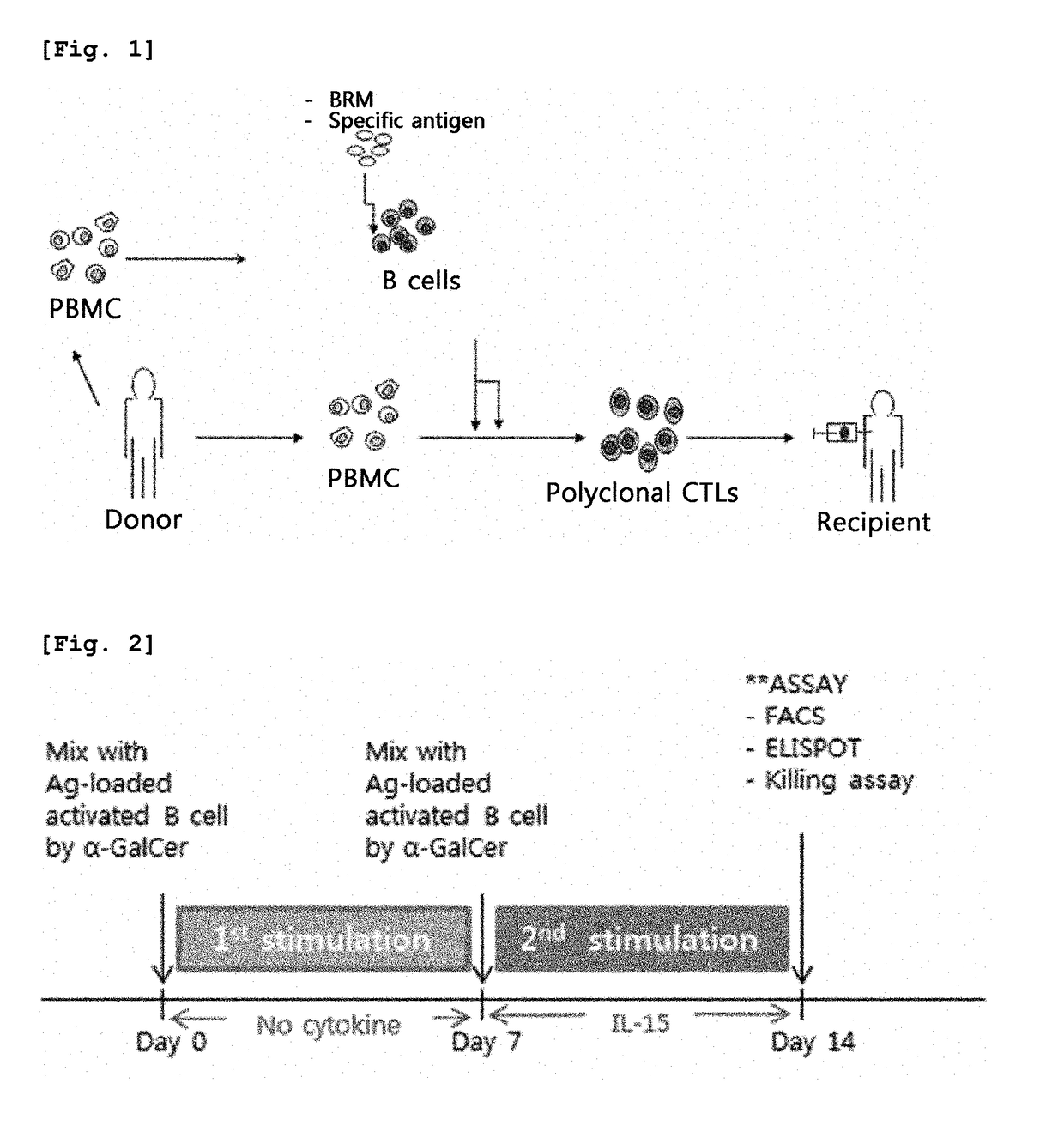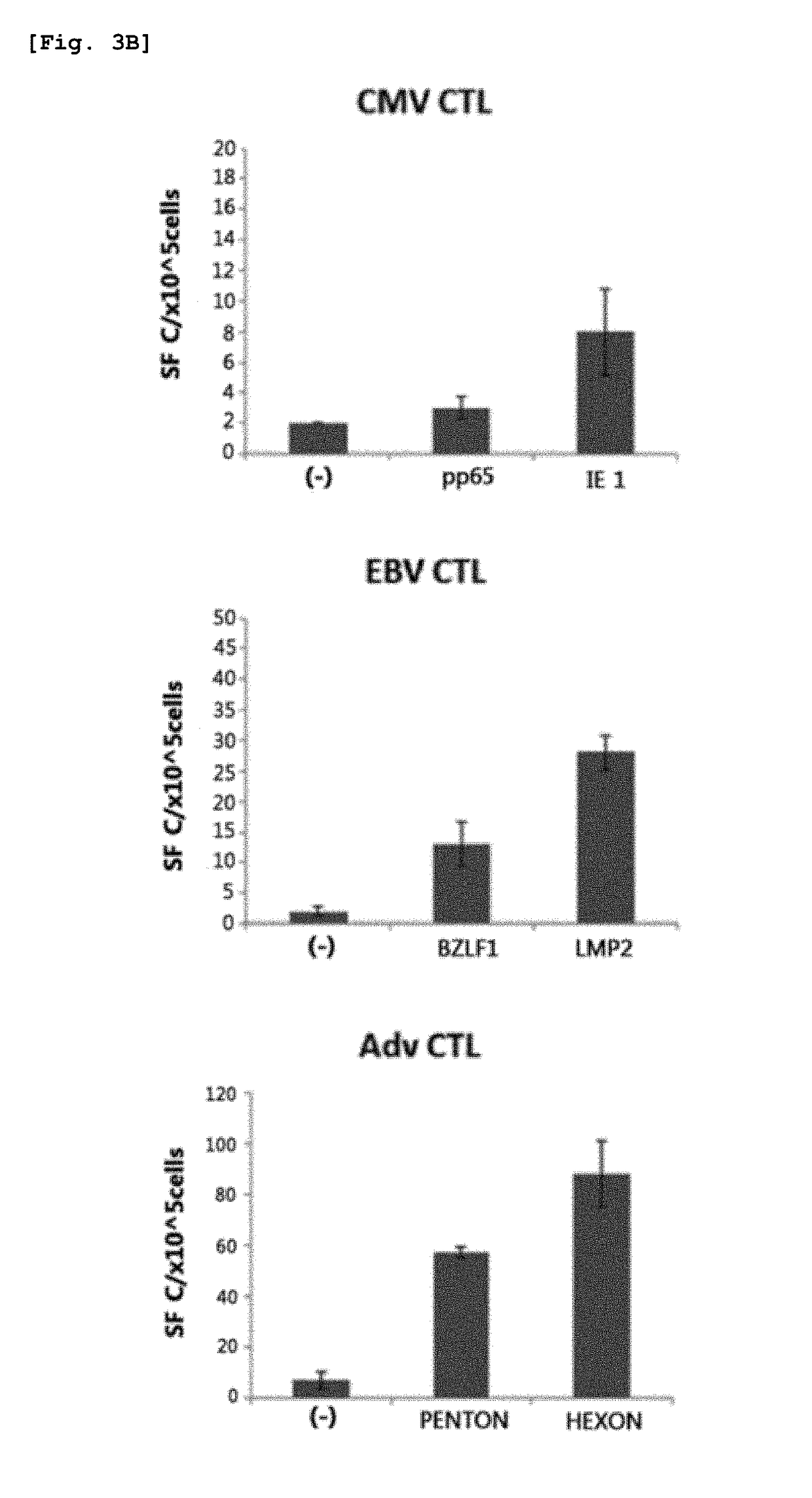Method for preparing antigen-specific cytotoxic t-cells by using activated b-cells and use thereof
a technology of activated b-cells and cytotoxic t-cells, which is applied in the field of cell production, can solve the problems of insufficient complete therapeutic methods, failure of hematopoietic stem cell transplantation, and lack of propter treatment for viral infections, and achieves the effect of longer production time and higher cos
- Summary
- Abstract
- Description
- Claims
- Application Information
AI Technical Summary
Benefits of technology
Problems solved by technology
Method used
Image
Examples
example 1
Isolation of B Cells from Peripheral Blood Mononuclear Cells and Activation of the B Cells
[0061]Human peripheral blood samples were collected from healthy volunteers under informed consent. Then, peripheral blood mononuclear cells (PBMCs) were isolated from the peripheral blood by Ficoll-paque™ plus (GE Healthcare) density gradient centrifugation according to the manufacturer's instructions. This study was approved by the Institutional Review Board for Human Research of Seoul National University (IRB No. C-1207-087-418).
[0062]After the density gradient centrifugation, using a B cell isolation kit II (Miltenyi Biotec, Bergisch Gladbach, Germany) according to the manufacturer's instructions, B cells were isolated from the PBMCs through negative selection using the anti-CD2, anti-CD14, anti-CD16, anti-CD36, anti-CD43 and anti-CD235a bound to magnetic microbeads. The purity of the isolated cells was analyzed using flow cytometry (FACSCanto™II, BD bioscience) and determined to be 95% or ...
example 2
Antigen Loading
2-1: Construction of Antigen-Encoding Plasmid and Loading by Nucleofection
[0064]The antigenic site of each of pCK-IE1-IRES-pp65 (IE1, pp65), pCK-E1dGALMP2-IRES-BZLF1 (E1dGALMP2, BZLF1) and pCK-HEXON-IRES-PENTON (HEXON, PENTON), which are plasmids encoding EBV, CMV and Adv antigens, respectively, was cloned into a pCK-IRES (ViroMed, Korea) vector, thereby constructing the following vectors, each encoding two of EBV, CMV and Adv antigens: pCK-IE1-IRES-pp65, pCK-E1dGALMP2-IRES-BZLF1 and pCK-HEXON-IRES-PENTON. WT1 (Wilms Tumor) gene (OriGene Inc. USA) was cloned into pCK-IRES (Viromed, Korea) vector to produce pCK-WT1.
[0065]The plasmids constructed as described above were then introduced into the activated B cells (prepared in Example 1) to load activated B cells with antigen using an AMAXA® Nucleofection® system (Lonza, USA) according to the manufacturer's instructions. Briefly, 1-5×106 activated B cells were nucleofected with 1-5 μg of plasmid DNA, and then incubated in...
example 3
Production of Cytotoxic T Cells
[0067]The mononuclear cells other than the B cells separated from PMBC in Example 1 were used as responder cells, and the nucleofected B cells and the antigen polypeptide-delivered B cells as described in Examples 2-1 and 2-2 were used as stimulator cells. The responder cells and the stimulator cells were co-cultured in RPMI 1640 medium containing 45% Click's medium (Irvine Scientific, CA, USA), 2 mmol / L Glutamax™-I and 10% FBS. At day 7 of culture, the cells were harvested and re-stimulated with stimulator cells. From day 7 of culture at the re-stimulation step, 50 ng / ml of IL-15 was added. After the re-stimulation, antigen-specific immune responses were assayed.
[0068]Specifically, for the first stimulation, the responder cells and the nucleofected B cells were mixed at a concentration ratio of 10:1 and co-cultured for 7 days without medium replacement. At day 7, the cells were harvested, mixed with fresh batch of nucleofected activated B cells at a r...
PUM
| Property | Measurement | Unit |
|---|---|---|
| concentration | aaaaa | aaaaa |
| concentration | aaaaa | aaaaa |
| time | aaaaa | aaaaa |
Abstract
Description
Claims
Application Information
 Login to View More
Login to View More - R&D
- Intellectual Property
- Life Sciences
- Materials
- Tech Scout
- Unparalleled Data Quality
- Higher Quality Content
- 60% Fewer Hallucinations
Browse by: Latest US Patents, China's latest patents, Technical Efficacy Thesaurus, Application Domain, Technology Topic, Popular Technical Reports.
© 2025 PatSnap. All rights reserved.Legal|Privacy policy|Modern Slavery Act Transparency Statement|Sitemap|About US| Contact US: help@patsnap.com



